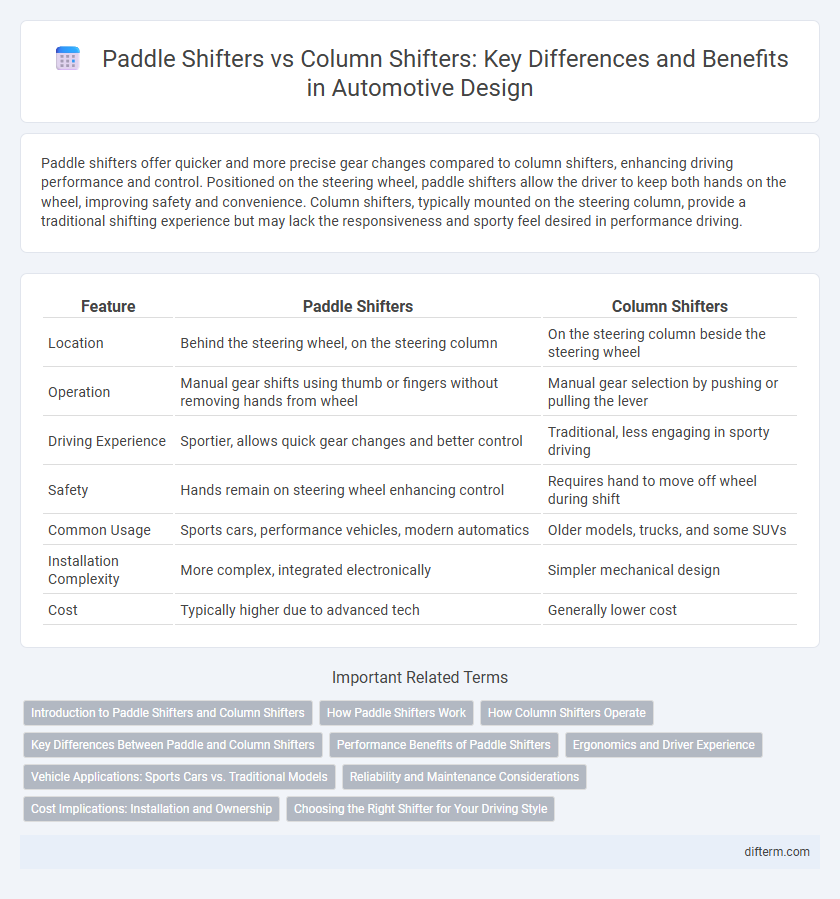Paddle shifters offer quicker and more precise gear changes compared to column shifters, enhancing driving performance and control. Positioned on the steering wheel, paddle shifters allow the driver to keep both hands on the wheel, improving safety and convenience. Column shifters, typically mounted on the steering column, provide a traditional shifting experience but may lack the responsiveness and sporty feel desired in performance driving.
Table of Comparison
| Feature | Paddle Shifters | Column Shifters |
|---|---|---|
| Location | Behind the steering wheel, on the steering column | On the steering column beside the steering wheel |
| Operation | Manual gear shifts using thumb or fingers without removing hands from wheel | Manual gear selection by pushing or pulling the lever |
| Driving Experience | Sportier, allows quick gear changes and better control | Traditional, less engaging in sporty driving |
| Safety | Hands remain on steering wheel enhancing control | Requires hand to move off wheel during shift |
| Common Usage | Sports cars, performance vehicles, modern automatics | Older models, trucks, and some SUVs |
| Installation Complexity | More complex, integrated electronically | Simpler mechanical design |
| Cost | Typically higher due to advanced tech | Generally lower cost |
Introduction to Paddle Shifters and Column Shifters
Paddle shifters are electronic controls mounted on the steering wheel, enabling drivers to manually shift gears without removing their hands from the wheel, enhancing both performance and safety. Column shifters, traditionally located on the steering column, provide a more conventional gear selection method commonly found in older or entry-level vehicles. Both shifting mechanisms impact driving experience and vehicle ergonomics, with paddle shifters offering quicker gear changes suited for sporty driving and column shifters prioritizing straightforward operation.
How Paddle Shifters Work
Paddle shifters operate through electronic sensors mounted behind the steering wheel, allowing drivers to change gears by pulling paddles with their fingers without removing hands from the wheel. These inputs send signals to the transmission control unit (TCU), which adjusts gear engagement in real time for seamless shifting and enhanced driving responsiveness. Compared to column shifters, paddle shifters provide quicker gear changes, improving performance in sports and performance vehicles.
How Column Shifters Operate
Column shifters operate via a mechanical linkage connected directly to the transmission, allowing the driver to change gears by moving the lever up or down along the steering column. This design saves space on the center console and enables quick gear selection without requiring the driver to move their hand far from the steering wheel. Column shifters are commonly found in trucks and older vehicles, providing a straightforward and reliable shifting mechanism.
Key Differences Between Paddle and Column Shifters
Paddle shifters offer rapid gear changes and are ergonomically positioned on the steering wheel for easy access without removing hands, enhancing driving performance in sports and luxury vehicles. Column shifters are mounted on the steering column, providing a traditional mechanical feel and freeing up center console space, often favored for simplicity and ease of use in everyday vehicles. The key differences lie in their placement, user interface, and the driving experience they deliver--paddle shifters prioritize speed and control, while column shifters prioritize familiarity and functionality.
Performance Benefits of Paddle Shifters
Paddle shifters offer faster and more precise gear changes compared to column shifters, enhancing overall vehicle performance and driver control. Their ergonomic placement behind the steering wheel allows for quicker, seamless shifting without the need to remove hands, reducing shift times and maintaining optimal engine RPM. This results in improved acceleration, smoother driving dynamics, and a more engaging driving experience, especially in high-performance and sports vehicles.
Ergonomics and Driver Experience
Paddle shifters offer superior ergonomics by allowing drivers to change gears without removing their hands from the steering wheel, enhancing control and safety during dynamic driving. Column shifters can cause more hand movement and distraction, potentially reducing responsiveness and comfort on long drives. The seamless integration of paddle shifters improves driver experience by promoting faster, more intuitive gear changes and reducing fatigue.
Vehicle Applications: Sports Cars vs. Traditional Models
Paddle shifters are predominantly found in sports cars and high-performance vehicles where quick, precise gear changes enhance driving dynamics and control. Traditional column shifters remain common in standard models and family vehicles, prioritizing ease of use and cost efficiency. The choice between paddle and column shifters reflects the vehicle's target market, driving experience, and design priorities.
Reliability and Maintenance Considerations
Paddle shifters typically offer greater reliability due to their electronic design, which reduces mechanical wear compared to column shifters that rely on physical linkages prone to wear and alignment issues. Maintenance for paddle shifters often involves software diagnostics and occasional sensor calibration, whereas column shifters may require mechanical adjustments or replacement of worn components such as cables and levers. In terms of longevity, paddle shifters generally require less frequent intervention, enhancing overall durability in modern automotive systems.
Cost Implications: Installation and Ownership
Paddle shifters typically incur higher installation costs due to their integration with advanced electronic systems and steering wheel components, increasing initial vehicle manufacturing expenses. Column shifters offer a more cost-effective solution, leveraging simpler mechanical linkages that reduce both installation complexity and long-term maintenance costs. Ownership expenses for paddle shifter-equipped vehicles may rise due to specialized repairs and software updates, whereas column shifters benefit from established, less costly servicing.
Choosing the Right Shifter for Your Driving Style
Paddle shifters offer rapid, precise gear changes ideal for aggressive driving and sports cars, enhancing control without removing hands from the steering wheel. Column shifters provide a more traditional, ergonomic feel suited to relaxed driving and vehicles prioritizing comfort and practicality. Selecting the right shifter depends on whether the driver values dynamic performance or everyday convenience in automotive transmission control.
paddle shifters vs column shifters Infographic

 difterm.com
difterm.com